Displaced Venezuelans in Latin America: A Test of Regional Solidarity?

Since 2015, South American countries have been dealing with the greatest forced displacement in their history. More than 5.6 million Venezuelans have left their country under great hardships, fleeing deteriorating living conditions, famine, and lack of access to medical treatment and basic care. Eighty per cent of these people have gone to other South American countries, such as Colombia, Peru, Ecuador, or Chile.

The reception of Venezuelan migrants and refugees is a major challenge for the region. South America has experienced substantial migration flows in the past, whose specificities inspired the foundation of a whole set of institutions, systems, practices, and frameworks for migration governance. This governance is characterized by an open approach to migration and migrants’ rights.
This framework has not been applied to address this migration crisis. Destination countries have had to adapt their migration policies and social systems to deal with the sudden arrival of large numbers of Venezuelans. The approach of Latin American countries has been disjointed and inconsistent. Most countries have opted for restrictive measures, imposing visas and deporting migrants, while fewer countries have decided to respect their traditions of compassion and grant Venezuelans a right of residence.
This policy paper addresses regional governance of migration in Latin America and underlines its inconsistencies while facing the largest displacement crisis ever experienced in the region. The paper highlights the landmark case of Colombia, which received 1.7 million Venezuelans and has recently decided to grant them a right of residence as a response to the social, economic, and geographical realities of Latin America.
Download the full analysis
This page contains only a summary of our work. If you would like to have access to all the information from our research on the subject, you can download the full version in PDF format.
Displaced Venezuelans in Latin America: A Test of Regional Solidarity?




